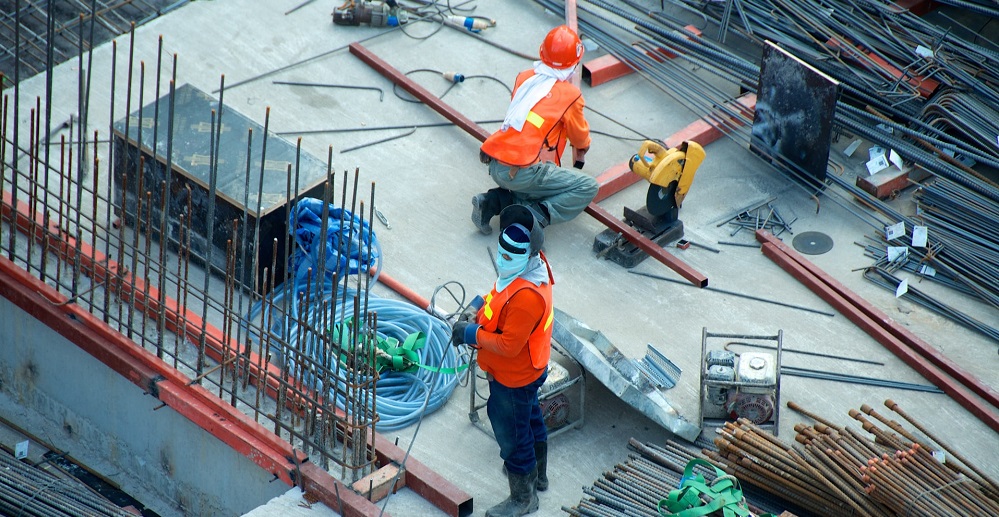Total construction starts rose 9% in February to a seasonally adjusted annual rate of $1.013 trillion, according to Dodge Construction Network. Nonresidential building starts swelled 32% due to the start of three large manufacturing facilities. By contrast, residential starts fell 3%, and nonbuilding starts fell by less than 1%. Without the three large manufacturing projects, total construction would have declined 6% in February.
The Dodge Momentum Index increased 4% in February to 158.2 (2000=100), from the revised January reading of 151.9. The Momentum Index, issued by Dodge Construction Network, is a monthly measure of the initial report for nonresidential building projects in planning, which have been shown to lead construction spending for nonresidential buildings by a full year. In February, institutional planning rose 9%, and commercial planning moved 1% higher. The Dodge Momentum Index rebounded from three consecutive monthly declines that followed a 14-year high in October 2021
Total construction starts increased 4% in January to a seasonally adjusted annual rate of $923.4 billion, according to Dodge Construction Network. Nonresidential building starts increased 4%, and nonbuilding starts rose 18%. Residential starts fell 1%. Compared to one year ago, total construction was 8% higher in January 2022 than in January 2021. Nonresidential building starts were up 14%, nonbuilding starts rose 12% and residential starts gained 2%. For the 12 months ending January 2022, total construction starts were 13% above the 12 months ending January 2021.
The Dodge Momentum Index declined 7% in January to a four-month low of 152.9 (2000=100), from the revised December reading of 163.7. The Momentum Index, issued by Dodge Construction Network, is a monthly measure of the initial report for nonresidential building projects in planning, which have been shown to lead construction spending for nonresidential buildings by a full year. In January, commercial planning fell 9%, and institutional planning slipped 1%. The Dodge Momentum Index had a stellar 2021, rising 23% from 2020 and reaching levels not seen in nearly 14 years.
The value of commercial and multifamily construction starts in the top 20 metropolitan areas of the U.S. increased 18% from 2020 to 2021, according to Dodge Construction Network. Nationally, commercial and multifamily construction starts increased 16% in 2021. In the leading half (the top 10 metro areas), commercial and multifamily starts rose 18% in 2021, with two metro areas, Washington, DC, and Los Angeles, CA, posting a decline. In the lesser half of metro areas (those ranked 11 through 20), commercial and multifamily starts rose 17% in 2021, with Chicago, IL, and Nashville, TN, losing ground from 2020.
Total construction starts were flat in December with a seasonally adjusted annual rate of $879.3 billion, according to Dodge Construction Network. Residential construction starts gained 4% in December 2021, while nonresidential building starts improved by 3%. Nonbuilding starts, however, declined 12%. Across 2021, total construction starts rose by 12% compared to 2020. Residential starts moved 20% higher, and nonresidential buildings increased 12%. Nonbuilding starts were flat in 2021.
Total construction starts fell 14% in November to a seasonally adjusted annual rate of $867.8 billion, according to Dodge Construction Network. Nonbuilding and nonresidential building starts bore the brunt of the decline, falling 30% and 21% respectively after seeing sharp increases in October as three large projects broke ground. Residential starts gained a modest 3%. Without October’s large projects, total construction starts in November would have increased by 5%.
The Dodge Momentum Index fell 4% in November to 171.7 (2000=100) — down from the revised October reading of 178.1. The Momentum Index, issued by Dodge Construction Network, is a monthly measure of the initial report for nonresidential building projects in planning, which have been shown to lead construction spending for nonresidential buildings by a full year. In November, commercial planning fell 8% while institutional planning moved 5% higher.
Total construction starts pushed 16% higher in October to a seasonally adjusted annual rate of $1.01 trillion, according to Dodge Construction Network. Nonresidential building starts gained 29% and nonbuilding moved 52% higher in October, while residential starts lost 8%. The month’s large gains resulted from the start of three large projects: two massive manufacturing plants and an LNG export facility. Without these projects, total construction starts would have fallen 6% in October.
The Dodge Momentum Index increased 10% in October to 181.2 (2000=100), from the revised September reading of 164.6. The Momentum Index, issued by Dodge Construction Network, is a monthly measure of the initial report for nonresidential building projects in planning, which have been shown to lead construction spending for nonresidential buildings by a full year. In October, commercial planning rose 14% and institutional gained 3%. The value of nonresidential building projects entering planning has staged a solid recovery this fall.
Total construction starts rose 10% in September to a seasonally adjusted annual rate of $889.7 billion, according to Dodge Construction Network. All three sectors improved: nonresidential building starts rose 15%, residential starts moved 9% higher, and nonbuilding starts increased by 6%. “Construction starts have struggled over the last three months as concerns over rising prices, shortages of materials, and scarce labor led to declines in activity,” stated Richard Branch, Chief Economist for Dodge Construction Network.
The Dodge Momentum Index gained 11% in September to 164.9 (2000=100) from the revised August reading of 148.0. The Momentum Index, issued by Dodge Construction Network, is a monthly measure of the initial report for nonresidential building projects in planning, which have been shown to lead construction spending for nonresidential buildings by a full year. The commercial planning component increased by 13% in September, while the institutional component rose 8%.
Total construction starts fell 9% in August to a seasonally adjusted annual rate of $782.8 billion, according to Dodge Data & Analytics. All three sectors lost ground during the month: nonbuilding starts were down 2%, residential starts were 9% lower, and nonresidential building starts fell 13%. “Construction starts have hit a rough patch following the euphoria seen in the early stages of recovery from the pandemic,” stated Richard Branch, Chief Economist for Dodge Data & Analytics.
The Dodge Momentum Index dropped 3% in August to 148.7 (2000=100) from the revised July reading of 154.0. The Momentum Index, issued by Dodge Data & Analytics, is a monthly measure of the first (or initial) report for nonresidential building projects in planning, which have been shown to lead construction spending for nonresidential buildings by a full year. The commercial planning component lost 2% in August, while the institutional component fell by 6%.
Total construction starts fell 3% in July to a seasonally adjusted annual rate of $854.8 billion, according to Dodge Data & Analytics. There were few bright spots during the month, with all three sectors (residential, nonresidential building and nonbuildings) moving lower in July. “Construction material prices continue their march higher and are weighing heavily on construction starts,” stated Richard Branch, Chief Economist for Dodge Data & Analytics. “Lumber and copper prices have fallen in recent weeks
The Dodge Momentum Index fell to 155.8 (2000=100) in July, a 6% decline from the revised June reading of 164.9. The Momentum Index, issued by Dodge Data & Analytics, is a monthly measure of the first (or initial) report for nonresidential building projects in planning, which have been shown to lead construction spending for nonresidential buildings by a full year. Both components of the Momentum Index fell in July. Commercial planning fell 3%, while institutional planning dropped 9%.
The value of commercial and multifamily starts in the top 20 metropolitan areas of the U.S. gained 12% during the first six months of 2021 relative to the first half of 2020, according to Dodge Data & Analytics. Nationally, commercial and multifamily construction starts were 10% higher on a year-to-date basis through six months. In the top 10 metro areas, commercial and multifamily construction starts were up 12% through six months, with only three metro areas – Washington DC, Los Angeles CA, and Austin TX – posting declines.
Total construction starts lost 7% in June, slipping to a seasonally adjusted annual rate of $863.6 billion, according to Dodge Data & Analytics. All three major sectors (residential, nonresidential building, and nonbuilding) pulled back during the month. Single family housing starts are feeling the detrimental effects of rising materials prices. Large projects that broke ground in May were absent in June for nonresidential building and nonbuilding starts, resulting in declines.
Total construction starts dropped 1% in May to a seasonally adjusted annual rate of $902.8 billion, according to Dodge Data & Analytics. The brunt of the decline was borne by residential starts, while nonresidential and nonbuilding starts continued their recovery from the COVID-19 pandemic. “The weight of higher material prices and a lack of skilled labor are having a direct and notable influence on residential construction activity,” said Richard Branch, Chief Economist for Dodge Data & Analytics.
The Dodge Momentum Index moved 9.1% higher in May to 178.0 (2000=100), up from the revised April reading of 163.2. The Momentum Index, issued by Dodge Data & Analytics, is a monthly measure of the first (or initial) report for nonresidential building projects in planning, which have been shown to lead construction spending for nonresidential buildings by a full year.


























